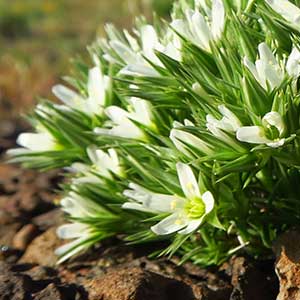Eremogone franklinii
Eremogone macradenia
Franklin's sandwort
desert sandwort, Mohave sandwort, Mojave or desert sandwort, Mojave sandwort
erect, 3–10(–15) cm, glabrous.
erect, (10–)20–40(–70) cm, glabrous to stipitate-glandular.
basal leaves persistent;
cauline leaves in 6–10 pairs, closely overlapping, not reduced;
basal blades arcuate-spreading, needlelike, (0.6–)1–2 cm × ca. 1 mm, ± rigid, herbaceous, apex spinose, glabrous, not glaucous.
basal leaves sparse or absent;
cauline leaves usually in 5–12+ pairs, not significantly reduced;
basal blades ascending to arcuate-spreading or recurved, needlelike or narrowly linear, (0.7–)2–6(–7) cm × 0.8–2 mm, ± rigid, herbaceous to subsucculent, apex blunt to spinose, glabrous, not glaucous.
3–45+-flowered, usually congested, subcapitate cymes.
3–20(–30)-flowered, ± compact cymes;
branches ascending to erect.
ca. 0.1–3(–4) mm, glabrous.
3–45 mm, glabrous or stipitate-glandular.
sepals 1–3-veined, linear-lanceolate, (5–)8.5–12 mm, not enlarging in fruit, margins narrow, apex acuminate, glabrous;
petals white, oblong-lanceolate to narrowly spatulate, 7–9 mm, 0.8–1.1 times as long as sepals, apex rounded to blunt;
nectaries not apparent.
sepals 1–3-veined, ovate to lanceolate or elliptic, 4.5–7.2 mm, to 8 mm in fruit, margins narrow to broad, apex acute to acuminate, glabrous to sparsely stipitate-glandular;
petals white or yellowish, oblanceolate to spatulate, 6–11 mm, 1–2 times as long as sepals, apex entire or erose;
nectaries thickened, molarlike, apically 2-lobed, 1–1.5 mm, or narrowly longitudinally rectangular, truncate, 0.7–0.8 mm, densely minutely pubescent with erect to spreading hairs.
2.3–3.3 mm, glabrous.
6–8 mm, glabrous.
black, pyriform, 1.2–1.7 mm, tuberculate.
greenish or reddish brown to blackish, suborbicular to pyriform or ovoid, 1.3–3.2 mm, tuberculate, sometimes echinate on abaxial ridge;
tubercles low, rounded to conic.
Eremogone franklinii
Eremogone macradenia
Varieties 2 (2 in the flora).
(Discussion copyrighted by Flora of North America; reprinted with permission.)
Varieties 2 (2 in the flora).
Eremogone macradenia is in the Center for Plant Conservation’s National Collection of Endangered Plants.
(Discussion copyrighted by Flora of North America; reprinted with permission.)
1. Inflorescences tightly congested cymes; pedicels 0.1-1(-3) mm; sepals 8.5-12 mm; petals 0.8-0.9 times as long as sepals | var. franklinii |
1. Inflorescences somewhat congested cymes; pedicels 1-4 mm; sepals 5-8 mm; petals 1-1.1 times as long as sepals | var. thompsonii |
1. Cauline leaves mostly in 5-8 pairs, blade ± ascending throughout, 0.8-1.2 mm wide | var. macradenia |
1. Cauline leaves mostly in 6-12+ pairs, blade curved downward, especially proximal ones, 1.2-2 mm wide | var. arcuifolia |
- Local floras:
OR,
WA
- Local Web sites:
CalFlora,
CalPhotos,
Flora NW,
PNW Herbaria
WildflowerSearch
iNaturalist (observations)
- LBJ Wildflower Center
- SEINet
- Plants of the World Online
- Encyclopedia of Life
- Wikipedia
- Google Image Search
